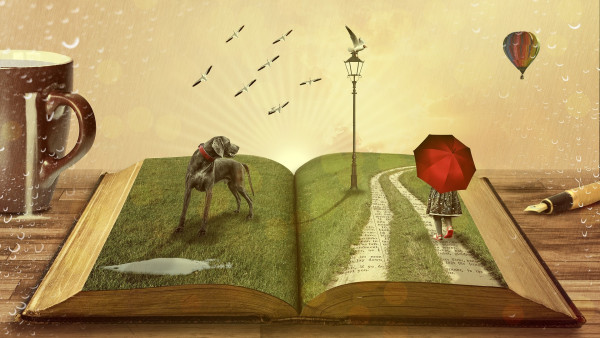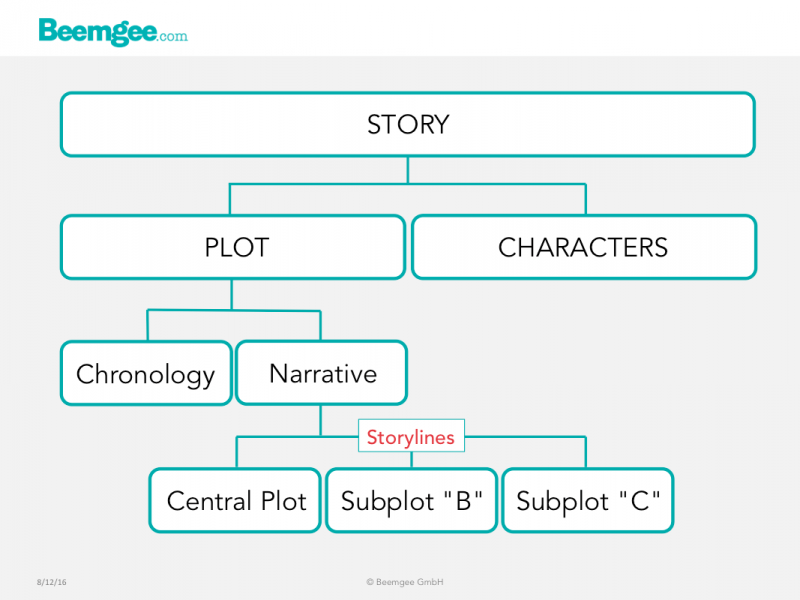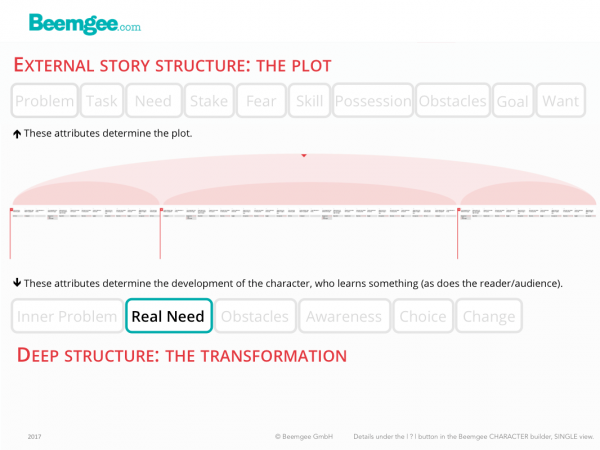Some Points to Ponder.

Should we reassess the success of our storytelling?
The Evolution of Stories
In previous posts we described the evolutionary case for storytelling. There is a point to telling stories, a reason why we do it. Stories have a deep “biological” function. The idea is that the fact that we as a species tell each other stories is an evolutionary adaptation which has increased our ability to survive and thrive on this planet.
And while the argument seems very plausible to us, the description of humans as “the storytelling animal” also seems to us to indicate the typical hubris of our species. By calling ourselves that, we set ourselves apart from the other animals who share our planet, who ostensibly are not intelligent or gifted enough to be endowed with an instinct for narrative.
But who is to say that whales, wolves, or even bees don’t tell each other stories?
If an elephant never forgets, surely their memories are filled with events and occurrences? And who is to say there are no plots and characters in these reminiscences, no themes or motifs in those recollections, no dramaturgy to those pachiderm pasts? (more…)

A story has a beginning, a middle, and an end. How to avoid the ‘saggy middle’.
The middle bit of a story is really the story proper. It is usually the longest section. It comes after the introduction of the main character(s) and the setting up of the context, that is the world of the story, as well as the problems and themes the story deals with.
At the end of the first section – prior to what we’re here calling ‘the middle bit’ –, the protagonist has decided to set off on the story journey. Obviously, this does not have to be physical journey through a particular geography, but it does mean that the main character is somehow entering into new and unfamiliar terrain. In this sense, every story is a ‘fish out of water’ story. The heroine must leave the comfort zone in order for the audience to feel interest in her plight.
Some authors jump right into this unfamiliar territory, showing the run up to it in flashbacks. Anita Brookner’s heroine Edith Hope has already arrived in the Hotel du Lac in the first sentence of the novel. Gradually the reasons for her stay here are revealed as the reader progresses through the novel.
Nonetheless, for an author, it may be advisable to create a marked threshold where the protagonist enters into the alien territory of the middle bit. The exploration and transversal of this territory is what on a plot level the middle bit is about, and it takes up the greater part of the story journey. (more…)
What a character might know that others don’t – including the audience

Some characters have secrets. We are not necessarily talking about their internal problem or the need that arises out of it (they may be aware of such a problem or not.) We are talking about information that makes a difference to the story once it is shared.
Character secrets are intimately bound to the scene type called a reveal (which does not necessarily have to entail a revelation).
In terms of story (or rather the dramaturgy of the story), if a character has a secret that is never revealed, the secret is irrelevant. Only if the secret is made known at some point in the narrative does it really exist as a component of the plot.
For authors, the main aspects of character secrets to control are:
- What plot event brings the secret about (this may be a backstory event)?
- How does the secret alter or determine the character’s decisions or behaviour?
- Does the character share the secret with another character at any point, and if so when (in which scene)?
- At what point in the narrative (in which scene) does the audience receive knowledge of this secret?
Who are you, really?
If it is so important the character has a secret, then, often, the secret becomes part of who this character is. Their role in the story, their identity within the story, is determined by their secret. So secrets are dramaturgically important. (more…)

The midpoint is structurally the most significant point in a narrative.
Given that stories have a tendency to symmetry, the centre of a narrative should mark the zenith of the story arc, and with that, the pivotal point of the story.
So, to get to (mid)point: What happens in the middle of a story?
Here are some typical midpoint events:
- Something searched for is found (Star Wars IV, Raiders of the Lost Ark, Lolita)
- A hidden truth is unveiled (to the audience, at least) – if not yet understood (Matrix, Pride and Prejudice, The Gruffalo)
- A dramatic event thwarts all plans made hitherto (James Cameron’s Titanic)
The centre of the narrative may be the discovery of something missing – in crime stories a vital piece of the puzzle may be revealed here (either to the audience or to the audience as well as the protagonist).
In any genre or dramatic category, the midpoint may be a moment of truth. This might be just a clue for the audience or perhaps an initial revelation of the true state of things.
If a character realises or finds out something that has so far been hidden, then this is the point at which the character begins to gain awareness. This counts in particular for the recognition of the character’s own internal problem. From here on the story might possibly lead up to a moment of choice at the crisis, when it becomes clear to the audience whether the character has learnt from this new awareness or not. In other words, the real need begins to overcome or supplant the character’s initial want due to what happens at the midpoint.
Some well-known examples of the midpoint
(more…)

Nothing should be more important to an author than how their story makes the audience feel.
As an author, consider carefully the emotional journey of the reader or viewer as they progress through your narrative.
The audience experiences a sequence of emotions when engaged in a narrative. So narrative structure is a vital aspect of storytelling. The story should be touching the audience emotionally during every scene. Furthermore, each new scene should evoke a new feeling in order to remain fresh and surprising.
The author’s job is to make the audience feel empathy with the characters quickly, so that an emotional response to the characters’ situation is possible. Only this can lead to physical reactions like accelerated heartbeat when the story gets exciting. We have to care.
This “capturing” of the audience, making the reader or viewer rapt and enthralled, requires authors to create events that will show who the characters are and how they react to the problems they must face. The audience is more likely to feel with the characters as the plot unfolds when the characters’ reactions to events reveal something about who they really are – and how they might be similar to us.
One Journey to Spellbind Them All
Here we present a loose pattern that we think probably fits for any type of story, whatever genre or medium, however “literary” or “commercial”. It’s not prescriptive, just a rough checklist of the stages in the emotional journey the audience tacitly expects when they let themselves in on a story. The emotions are in more or less the order they might be evoked by any narrative.
Curiosity
(more…)
Stories tend to show characters getting together.

Stories don’t get going until there are at least two characters.
That’s because the characters in themselves are not really what interests the audience. What the audience likes to experience is relationships.
At a fundamental level, there are only these three ways that people – or characters within a story – can interact with each other:
- they can cooperate
- they might oppose each other
- or they may get together
It is the complexities of these types of relationship that authors present to their audiences.
At least two of the three types of relationships are likely to be depicted in any story, cooperation and conflict. To make the story feel complete, authors especially of popular stories such as Hollywood movies often include the third type in the form of a love interest. (more…)
Archetypal Antagonism in Documentary Film and Fiction
by Amos Ponger of Mrs Wulf Story Consulting

Stories are intricate mechanisms
Documentary film is a powerful genre that draws much of its energy from the material of real-life action. Consuming documentaries, we as spectators often ignore the fact that documentaries, like fiction, are a constructed clockwork of storytelling. Since the digital revolution, the amounts of raw material for documentary productions have probably grown tenfold, shifting much of the dramaturgical construction work to the editing room. Dealing with hundreds of hours of material you may say that 90 percent of the editing work in documentary film is “finding the story“, discovering what your story is about.
One issue editors often encounter while working on the narratives of documentary films is that many directors tend to neglect the importance of understanding and designing their antagonist or their antagonistic powers, the Antagonism.
Sure, you love your protagonists. You identify with their strivings and journeys, and you as a storyteller have probably given a lot of thought to making them appealing to your audience, giving the audience someone they can identify with. Your protagonists may be an inspiration to you, or you may yourself strongly identify with them, you may share or appreciate some of their characteristics and values.
At the same time you have probably not given your Antagonist/m the same attention. Have you? (more…)
How narrative structure turns a story into an emotional experience.

Image: Comfreak, Pixabay
Storytelling is a bit of an overused buzzword. While we are all – by dint of being human – storytellers, how aware are you of the principles of dramaturgy? What exactly constitutes a story, in comparison to, say, a report or an anecdote?
And just to be clear, the following is not a story. It’s an how-to article.
Whatever the medium – film or text, online or offline –, storytelling has something to do with emotionally engaging an audience, that much seems clear. So is a picture of a cute puppy a story? Hardly.
Stories exist in order to create a difference in their audience. Stories always address problems and tend to convey the benefits of co-operative behaviour.
While there simply is no blueprint to how stories work, let’s examine the elements that recur in stories and try to find some patterns.
Who is the story about?
All stories are about someone. That someone does not have to be a person, it can be an animal (Bambi) or a robot (Wall-e). But a story needs a character. In fact, all stories have more than one character, with virtually no exceptions. This is because the interaction between several characters provides motivation, conflict and action.
Moreover, stories usually have a main character, the figure that the story seems to be principally about – the protagonist. It is not always obvious why one character is the protagonist rather than another. Is she simply the most heroic? Is she the one that develops most? Or does she just have the most scenes?(more…)
A plot arises out of the actions and interactions of the characters.
On the whole, you need at least two characters to create a plot. Add even more characters to the mix, and you’ll have possibilities for more than one plot.
Most stories consist of more than one plot. Each such plot is a self-contained storyline.

The Central Plot
Often there is a central plot and at least one subplot. The central plot is usually the one that arcs across the entire narrative, from the onset of the external problem (the “inciting incident” for one character) to its resolution. This is the plot that is at the(more…)
In stories, characters are faced with obstacles.
These obstacles come in various forms and degrees of magnitude. And they may have different dimensions: they may be internal, external, or antagonistic.
Often the obstacles that resound most with a significant proportion of the audience are the ones that force the main characters to face and deal with problems within themselves, in their nature. In other words, with their internal problem.
Internal obstacles are the symptoms of the characters’ flaws or shortcomings, i.e. of the internal problem. The audience perceives them in scenes in which the character’s flaw prevents her progress.
Not every story features characters with internal problems. An internal problem is not strictly speaking necessary in order to create an exciting story.
But it helps.
The Emotional Truth
An internal problem makes the character appear fallible – and thus more credible, more human, more like us. Internal problems are invariably emotional and private. They express(more…)
In most stories, what a character really needs is growth.

Characters display flaws or shortcomings near the beginning of the story as well as wants. What they really need to do in order to achieve what they want is likely to be something they need to become aware of first.
The real need relates to the internal problem in the same way the perceived need relates to the external problem. The character has some sort of dysfunction that really needs to be repaired.
That means the audience or reader may become aware of a character’s real need long before the character does. Most stories are about learning, and learning entails the uncovering of something previously unknown. So the real need of a character is to uncover the internal problem, to become aware of their flaw.
A character may be unaware of their real need because they are suppressing a secret from their past. Something they did (better than something that happened to them) causes shame or guilt and they therefore hide it from themselves. To get over this, they must achieve some sort of healing. The trick is to dramatise such inner conflict through plot events.
To recap: The usual mode in storytelling has a character consciously responding to an external problem with a want, a goal, and a number of perceived needs. Unconsciously, that character may well have a character trait that amounts to an internal problem, out of which arises that character’s real need – i.e. to solve the internal problem.
So if a character is selfish, the real need is to learn selflessness. If the character is overly proud, then he or she needs to gain some humility. In the movie Chef, the father neglects his son emotionally – his real need is to learn to involve the child in his own life. The audience sees this way before the Chef does.
Even stories in which the external problem provides the entertainment – and with that the raison d’être of the story – may profit from(more…)
What’s the problem? Does the character know?
In storytelling, discrepancy between a character’s awareness and the awareness-levels of others is one of the most powerful devices an author can use. “Others” refers here not just to other characters, but to the narrator and – most significantly – to the audience/reader.
Let’s sum up potential differences in knowledge or awareness:
- A character’s awareness of his or her own internal problem or motivation
- A difference between one character’s knowledge of what’s going on and another’s
- The narrator knows more about what is going on than the character
- The audience/reader knows more than the character – dramatic irony
In this post, we’ll concentrate on the first point: Awareness of the internal problem. We’ll break that down into
- Becoming Aware – the importance of the revelation
- The Story Journey – and where to place the revelation
- Surface Structure and Deep Structure
- The Need for Awareness – or, Alternatives to Revelation
Becoming Aware – the importance of the revelation (more…)











